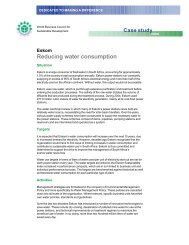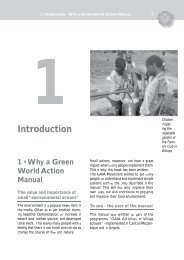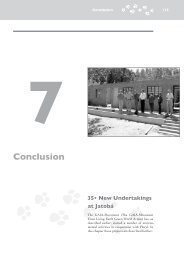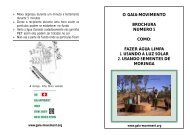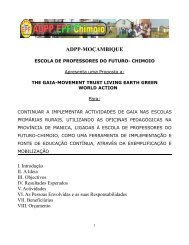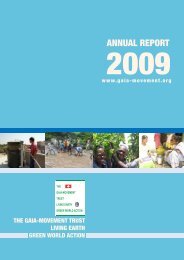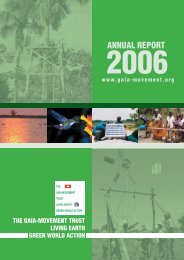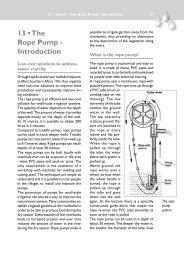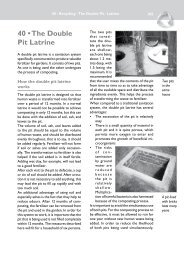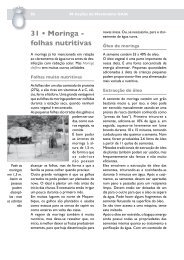PDF file, 129 KB - Right click + "save target as...." - The Gaia ...
PDF file, 129 KB - Right click + "save target as...." - The Gaia ...
PDF file, 129 KB - Right click + "save target as...." - The Gaia ...
You also want an ePaper? Increase the reach of your titles
YUMPU automatically turns print PDFs into web optimized ePapers that Google loves.
8<br />
www.gaia-movement.org<br />
Booklet - Conservation Farming<br />
Generally the soil is very hard<br />
to till before the rains fall. This<br />
is especially the c<strong>as</strong>e for<br />
farmers Manual who - Fire use animals. <strong>The</strong>se<br />
are weak after the long dry<br />
se<strong>as</strong>on.<br />
In minimum tillage the compost<br />
and manure is placed directly<br />
in each planting hole. It is thus<br />
used more efficiently than<br />
when it is spread over the hole<br />
field.<br />
Minimum tillage requires<br />
inicially more time for weeding.<br />
<strong>The</strong> household must avoid<br />
planting on a larger area than<br />
they have the capacity to<br />
maintain. But if the weeding is<br />
done well from the beginning,<br />
then the land will after a few<br />
years have less weeds because<br />
less and less seeds get the<br />
chance to germinate.<br />
This manual w<strong>as</strong> elaborated by:<br />
Development Aid from People to<br />
People (DAPP),<br />
Child Aid & Environment ,<br />
Southern Province, Zambia.<br />
Summing up one can say that<br />
minimum tillage <strong>save</strong>s water,<br />
soil and money.<br />
THE<br />
THE<br />
GAIA-MOVEMENT<br />
GAIA-MOVEMENT<br />
TRUST<br />
TRUST<br />
LIVING LIVING LIVING EAR EARTH EAR TH<br />
GREEN GREEN WORLD WORLD ACTION<br />
ACTION<br />
<strong>The</strong> GAIA-Movement Booklet - Conservation - Conservation Farming Booklet Farming 23 1<br />
CONSERVATION<br />
FARMING<br />
What you should know about the sustainable<br />
farming system - Conservation Farming<br />
What is minimum<br />
tillage<br />
Minimum tillage simply means<br />
that the land is not tilled deeply:<br />
no ploughing, no digging of<br />
ridges, no deep digging with a<br />
hoe. In many parts of Zambia -<br />
where farmers had no draft<br />
animals - minimum tillage h<strong>as</strong><br />
been carried out for centuries.<br />
<strong>The</strong> Conservation<br />
Farming System<br />
This method w<strong>as</strong> developed in<br />
Zimbabwe, and h<strong>as</strong> shown<br />
excellent results in Zambia. <strong>The</strong><br />
farmer digs a hole at every<br />
planting station. This should be<br />
done during the dry se<strong>as</strong>on, so<br />
the farmer will be ready to<br />
plant the very first day after the
2<br />
Booklet - Conservation Farming<br />
sunset of the rain. <strong>The</strong> method<br />
must be followed by soil<br />
conservation methods such <strong>as</strong><br />
crop Manual rotation - Fire with legumes<br />
crops, no burning of crop<br />
residues and if needed,<br />
establishment of contour<br />
bunds, in order to get the best<br />
results.<br />
Advantages of<br />
Conservation Farming<br />
<strong>The</strong> farmer will be able to<br />
plant the crop early and will<br />
at the same time be ready<br />
to start the weeding. This<br />
will incre<strong>as</strong>e the yield and<br />
food security, <strong>as</strong> early<br />
planted and well weeded<br />
crops give the best results<br />
<strong>The</strong> holes will concentrate<br />
rainfall around the plant,<br />
and this will improve<br />
growth of the crop in c<strong>as</strong>e<br />
of little rainfall<br />
<strong>The</strong> holes should be dug<br />
using a string. This will<br />
secure correct spacing of<br />
the crop<br />
Manure will be applied in<br />
each planting hole - which<br />
will make the manure go a<br />
long way. <strong>The</strong> accurate<br />
planting will give a good<br />
germination percentage and<br />
will therefore reduce the<br />
amount of seeds needed<br />
Fertiliser is applied into the<br />
planting holes. This makes it<br />
e<strong>as</strong>y to give the correct<br />
amount and make it more<br />
difficult for heavy rain, to<br />
w<strong>as</strong>h away the fertiliser<br />
<strong>The</strong> soil structure will<br />
improve, if the land is not<br />
ploughed over some years<br />
- especially if other<br />
conservation farming<br />
methods are used in<br />
combination with minimum<br />
tillage.<br />
Booklet - Conservation - Conservation Farming<br />
and leaves from this legume<br />
plant will have improved the<br />
soil fertility. Crops can be<br />
grown profitably without<br />
fertiliser.<br />
Improve crop yield<br />
with Faidherbia albida<br />
Faidherbia albida is also known<br />
<strong>as</strong> Acacia albida - or Musangu.<br />
This tree can with good result<br />
be left in the fields. <strong>The</strong> tree<br />
fertilises the soil and it does not<br />
compete with the crops for<br />
light, <strong>as</strong> it drops the leaves<br />
before the rainy se<strong>as</strong>on. Maize<br />
plants under Musangu trees<br />
give a very good yield.<br />
<strong>The</strong> b<strong>as</strong>ic concept of<br />
minimum tillage<br />
When the soil is tilled the good<br />
structure formed naturally is<br />
destroyed. <strong>The</strong> valuable humus<br />
is buried further down. <strong>The</strong> soil<br />
structure is spoiled and it is left<br />
without a protective cover. This<br />
results in soil erosion when<br />
heavy rains fall.<br />
With minimum tillage one<br />
works together with nature<br />
and not against nature.<br />
Never plough the soil, nut use<br />
this method of digging holes<br />
each time a crop is planted.<br />
<strong>The</strong>se holes attract water.<br />
<strong>The</strong> residues from former<br />
crops prevent evaporation of<br />
water from the soil, when they<br />
are left <strong>as</strong> a protective mulch.<br />
This furthermore prevents high<br />
soil temperatures that destroy<br />
living conditions for many soil<br />
organisms.<br />
Another advantage is that<br />
minimum tillage gives the<br />
possibility to prepare the land<br />
before the rains.<br />
7
6<br />
Booklet - Conservation Farming<br />
much in order to use oxen for<br />
cultivating (weeding) between<br />
the crops.<br />
Manual - Fire<br />
Rehabilitating<br />
degraded land with<br />
Tephrosia and Sesbania<br />
Land which h<strong>as</strong> been overused<br />
and h<strong>as</strong> lost fertility can be<br />
rehabilitated with the use of<br />
Tephrosia and Sesbania. This is<br />
a shrub which can grow 3 m<br />
high.<br />
Both are common plants in<br />
many are<strong>as</strong> of Zambia.<br />
Tephrosia contains a strong<br />
chemical and can be used <strong>as</strong> a<br />
natural pesticide. Tephrosia is<br />
not browsed by animals but<br />
Sesbania is liked especially by<br />
goats and needs protection.<br />
1. Dig the holes <strong>as</strong> for crops<br />
under minimum tillage (70<br />
cm between plants and 90<br />
cm between rows)<br />
2. Back fill the soil and plant 3<br />
seeds in each hole at a<br />
depth of 3 cm<br />
3. Keep the plants free from<br />
weeds, while they are still<br />
small<br />
4. Protect the seedlings<br />
against fire (make a<br />
firebreak)<br />
5. Fencing is not needed <strong>as</strong><br />
these plants are not<br />
browsed by livestock<br />
6. Leave the shrub in the field<br />
for 2 to 3 se<strong>as</strong>ons. Cut<br />
down the shrub (good<br />
firewood!)<br />
7. You can now grow crops<br />
on the land. <strong>The</strong> roots of the<br />
Tephrosia will have lifted<br />
hard plough pans. <strong>The</strong> roots<br />
Booklet - Conservation - Conservation Farming 3<br />
How to carry out<br />
Conservation Farming<br />
Step 1: Prepare the land<br />
Do not burn<br />
crop residues.<br />
Spread them<br />
out on the<br />
field.<br />
Step 2. Prepare a rope<br />
Prepare a rope, with bottle<br />
tops squeezed onto it at<br />
distances of 70 cm. If no bottle<br />
tops are available, you can make<br />
knots on the string using the<br />
same distance.<br />
Step 3. Mark out the<br />
planting holes<br />
Use the rope to mark the<br />
planting stations. Me<strong>as</strong>ure 90<br />
cm between each row with a<br />
90 cm long stick. It is worth<br />
marking out accurately in the<br />
first year, because the holes will<br />
be permanent.<br />
Step 4: Dig the holes<br />
Dig the holes around 35 cm (1<br />
foot) long, 15 cm wide and 15<br />
cm deep (like a hand).<br />
Dig the<br />
holes before<br />
onset of the<br />
rains - so<br />
you are<br />
ready to<br />
plant early.<br />
You can dig a<br />
few lines<br />
every day starting in August.<br />
Step 5. Application of<br />
manure and/or fertiliser<br />
Apply b<strong>as</strong>il dressing or manure<br />
in one end of the hole.<br />
This must be done together<br />
with planting the seeds or<br />
preferably before. Place one or<br />
two big cups of manure per<br />
hole and fertiliser <strong>as</strong><br />
recommended for the different<br />
varieties of crops.
4<br />
Booklet - Conservation Farming<br />
Step 6. Planting the crop<br />
Maize<br />
Plant Manual with the - Fire first good rain<br />
(mid November to mid<br />
December)<br />
Soak the seeds overnight (6<br />
hours) before planting - it will<br />
speed up germination. Plant 4<br />
seeds in the hole opposite the<br />
manure/fertiliser 3 cm deep.<br />
Plant the day after a good<br />
planting rain. Never plant into<br />
soil that is getting dry.<br />
Cotton<br />
Plant with the first good rain.<br />
(mid November to mid<br />
December)<br />
Back fill most of the soil into<br />
the hole leaving a small<br />
repression only. Plant 5 to 6<br />
seeds per hole, and cover very<br />
lightly.<br />
Cow Pea, Pigeon Pea, Gram<br />
Plant mid to end of December<br />
(You can plant some of the crop<br />
earlier, in order to get an early<br />
harvest for consumption). 5 to<br />
6 seeds per hole - 3 cm deep<br />
Groundnuts<br />
Plant with the first good rain.<br />
(mid to end of November)<br />
Plant 8 to 10 nuts across the<br />
hole - 3 cm deep<br />
Sunflower<br />
Plant between 1st -15th of<br />
December. 4 to 6 seeds per<br />
hole - 2 cm deep<br />
Step 7. Early weeding<br />
Start to weed <strong>as</strong> soon <strong>as</strong> weeds<br />
emerge. This makes the work<br />
e<strong>as</strong>ier and f<strong>as</strong>ter - it takes less<br />
time to weed a field with tiny<br />
weeds 4 times - than to weed<br />
a field with big weeds 2 times.<br />
When the weeds grow big the<br />
crops will suffer <strong>as</strong> the weed<br />
will steal nutrition, water and<br />
light from the crops.<br />
Step 8. Thinning<br />
Thin while the plants are still<br />
young in order not to disturb<br />
the surviving plants. Thin maize<br />
Booklet - Conservation - Conservation Farming<br />
to 3 plants per hole and cotton<br />
to 4 plants per hole.<br />
Step 9. Top dressing<br />
Add top dressing to maize<br />
when it is knee high. Place the<br />
fertiliser in a small hole 20 cm<br />
from the stand of maize - 1<br />
bottle top per station.<br />
Step 10. Mid and late se<strong>as</strong>on<br />
weeding<br />
Do not allow weeds to shed<br />
their seeds. As the land is not<br />
ploughed, the weed population<br />
will be smaller every year, if the<br />
weeds never shed their seeds.<br />
Step 11. Top the maize<br />
Once the maize is mature, it is<br />
a good idea to top the stalks<br />
just above the cobs, and drop<br />
the tops in the furrow. This will<br />
shed up the drying and reduce<br />
lodging from termites and wind.<br />
Minimum tillage using<br />
oxen<br />
Ripper<br />
A farmer can carry out<br />
minimum tillage using a ripper.<br />
A ripper does not turn around<br />
the soil, but loosen the soil in a<br />
furrow, in which the crop can<br />
be planted. This work can be<br />
done in the dry se<strong>as</strong>on, <strong>as</strong> it is<br />
not so heavy to pull compared<br />
with a plough. This will make<br />
the farmer ready to plant early.<br />
<strong>The</strong> ripper does not get<br />
disturbed by thr<strong>as</strong>h lying on the<br />
ground.<br />
Ploughing lines<br />
A farmer can decide to plough<br />
lines - instead of ploughing the<br />
whole field. <strong>The</strong> job will be done<br />
f<strong>as</strong>t and secure all crops being<br />
planted re<strong>as</strong>onably early,<br />
compared with conventional<br />
ploughing.<br />
Cultivating<br />
Cultivating does not turn<br />
around the soil and it is very<br />
5



